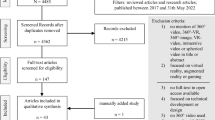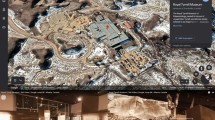Abstract
Videos are pivotal tools in pre-service teacher training. First-person, third-person, and 360-degree perspectives are commonly used types and the optimal type remains undetermined. In our study involving pre-service teachers (PSTs), we evaluated the efficacy of 360-degree videos against the first-person and third-person perspective videos concerning spatial presence, cognitive load, classroom quality rating accuracy, and classroom observation. Our results revealed that PSTs exposed to 360-degree videos exhibited superior performance in spatial presence, classroom quality rating accuracy, and classroom observation compared to the other two video types. This underscores that 360-degree videos enhance PSTs' skills in discerning, categorizing, and interpreting classroom events. Although there were no marked differences in cognitive load across the groups, cognitive load was found to modulate the influence of video type on classroom observation. Notably, at higher cognitive load levels, the 360-degree videos were more advantageous. The significance of this study is twofold: it empirically substantiates the superiority of 360-degree videos in refining pedagogical skills and it reveals the modulating role of cognitive load. These findings inform innovative instructional interventions and pedagogical strategies, emphasizing the need for using 360-degree videos in teacher education and encouraging higher learner engagement.






Similar content being viewed by others

Data availability
Materials and analysis data for this study are available by emailing the corresponding author on reasonable request.
References
Ardisara, A., & Fung, F. M. (2018). Integrating 360° videos in an undergraduate chemistry laboratory course. Journal of Chemical Education, 95(10), 1881–1884.
Atal, D., Admiraal, W., & Saab, N. (2023). 360° Video in teacher education: A systematic review of why and how it is used in teacher education. Teaching and Teacher Education, 135, 104349.
Balzaretti, N., Ciani, A., Cutting, C., O’Keeffe, L., & White, B. (2019). Unpacking the potential of 360-degree video to support pre-service teacher development. Research on Education and Media, 11(1), 63–69.
Barsalou, L. W. (2008). Grounded cognition. Annual Review of Psychology, 59(1), 617–645.
Beege, M., Schneider, S., Nebel, S., & Rey, G. D. (2020). Does the effect of enthusiasm in a pedagogical agent’s voice depend on mental load in the learner’s working memory? Computers in Human Behavior, 112, 106483.
Brand, S., Reimer, T., & Opwis, K. (2007). How do we learn in a negative mood? Effects of a negative mood on transfer and learning. Learning and Instruction, 17(1), 1–16.
Chen, O., Castro-Alonso, J. C., Paas, F., & Sweller, J. (2018). Extending cognitive load theory to incorporate working memory resource depletion: Evidence from the spacing effect. Educational Psychology Review, 30(2), 483–501.
Clark, R. E. (1983). Reconsidering research on learning from media. Review of Educational Research, 53(4), 445–459.
Cui, Y. (2012). On the Paradigm of LICC: A new way of profession classroom observation. Educational Research, 33(05), 79–83.
Dibble, J. L., Hartmann, T., & Rosaen, S. F. (2016). Parasocial interaction and parasocial relationship: Conceptual clarification and a critical assessment of measures. Human Communication Research, 42(1), 21–44.
Emmer, E. T., & Stough, L. M. (2001). Classroom management: A critical part of educational psychology, with implications for teacher education. Educational Psychologist, 36(2), 103–112.
Fadde, P., & Sullivan, P. (2013). Using interactive video to develop pre-service teachers’ classroom awareness. Contemporary Issues in Technology and Teacher Education, 13(2), 156–174.
Ferdig, R. E., & Kosko, K. W. (2020). Implementing 360 video to increase immersion, perceptual capacity, and teacher noticing. TechTrends, 64(6), 849–859.
Fiorella, L., van Gog, T., Hoogerheide, V., & Mayer, R. E. (2017). It’s all a matter of perspective: Viewing first-person video modeling examples promotes learning of an assembly task. Journal of Educational Psychology, 109(5), 653–665.
Flores, M. A. (2017). Practice, theory and research in initial teacher education: International perspectives. European Journal of Teacher Education, 40(3), 287–290.
Flower, A., McKenna, J. W., & Haring, C. D. (2017). Behavior and classroom management: Are teacher preparation programs really preparing our teachers? Preventing School Failure: Alternative Education for Children and Youth, 61(2), 163–169.
Freeman, J., Simonsen, B., Briere, D. E., & MacSuga-Gage, A. S. (2014). Pre-service teacher training in classroom management: A review of state accreditation policy and teacher preparation programs. Teacher Education and Special Education, 37(2), 106–120.
Freiberg, H. J., Huzinec, C. A., & Templeton, S. M. (2009). Classroom management—a pathway to student achievement: A study of fourteen inner-city elementary schools. The Elementary School Journal, 110(1), 63–80.
Gaudin, C., & Chaliès, S. (2015). Video viewing in teacher education and professional development: A literature review. Educational Research Review, 16, 41–67.
Gold, B., & Holodynski, M. (2017). Using digital video to measure the professional vision of elementary classroom management: Test validation and methodological challenges. Computers & Education, 107, 13–30.
Gold, B., & Windscheid, J. (2020). Observing 360-degree classroom videos–Effects of video type on presence, emotions, workload, classroom observations, and ratings of teaching quality. Computers & Education, 156, 103960.
Goldman, R. (2007). Video representations and the perspectivity framework: Epistemology, ethnography, evaluation, and ethics. Video Research in the Learning Sciences, 37, 3–37.
Hamari, J., Koivisto, J., & Sarsa, H. (2014). Does gamification work?–a literature review of empirical studies on gamification. In 2014 47th Hawaii International Conference on System Sciences (pp. 3025–3034). IEEE.
Hart, S. G., & Staveland, L. E. (1988). Development of NASA-TLX (Task Load Index): Results of empirical and theoretical research. In Advances in psychology (Vol. 52, pp. 139–183). North-Holland.
Huang, Y., Richter, E., Kleickmann, T., Wiepke, A., & Richter, D. (2021). Classroom complexity affects student teachers’ behavior in a VR classroom. Computers & Education, 163, 104100.
Huang, Y., Richter, E., Kleickmann, T., & Richter, D. (2023). Comparing video and virtual reality as tools for fostering interest and self-efficacy in classroom management: Results of a pre-registered experiment. British Journal of Educational Technology, 54(2), 467–488.
Kersting, N. B., Givvin, K. B., Sotelo, F. L., & Stigler, J. W. (2010). Teachers’ analyses of classroom video predict student learning of mathematics: Further explorations of a novel measure of teacher knowledge. Journal of Teacher Education, 61(1–2), 172–181.
Kersting, N. B., Givvin, K. B., Thompson, B. J., Santagata, R., & Stigler, J. W. (2012). Measuring usable knowledge: Teachers’ analyses of mathematics classroom videos predict teaching quality and student learning. American Educational Research Journal, 49(3), 568–589.
König, J., & Kramer, C. (2016). Teacher professional knowledge and classroom management: On the relation of general pedagogical knowledge (GPK) and classroom management expertise (CME). ZDM Mathematics Education, 48(1), 139–151.
König, J., Bremerich-Vos, A., Buchholtz, C., Lammerding, S., Strauß, S., Fladung, I., & Schleiffer, C. (2017). Modelling and validating the learning opportunities of pre-service language teachers: On the key components of the curriculum for teacher education. European Journal of Teacher Education, 40(3), 394–412.
Korthagen, F. (2017). Inconvenient truths about teacher learning: Towards professional development 3.0. Teachers and teaching, 23(4), 387–405.
Kosko, K. W., Heisler, J., & Gandolfi, E. (2022). Using 360-degree video to explore teachers’ professional noticing. Computers & Education, 180, 104443.
Lave, J., & Wenger, E. (1991). Situated learning: Legitimate peripheral participation. Cambridge University Press.
McIntyre, N. A., & Foulsham, T. (2018). Scanpath analysis of expertise and culture in teacher gaze in real-world classrooms. Instructional Science, 46(3), 435–455.
Nacke, L. E., & Deterding, S. (2017). The maturing of gamification research. Computers in Human Behavior, 71, 450–454.
Park, B., Moreno, R., Seufert, T., & Brünken, R. (2011). Does cognitive load moderate the seductive details effect? A multimedia study. Computers in Human Behavior, 27(1), 5–10.
Plass, J. L., Moreno, R., & Brünken, R. (2010). Cognitive load theory. Cambridge University Press.
Ramalho, J., & Chambel, T. (2013). Immersive 360 mobile video with an emotional perspective. In Proceedings of the 2013 ACM international workshop on Immersive media experiences (pp. 35–40).
Richter, E., Hußner, I., Huang, Y., Richter, D., & Lazarides, R. (2022). Video-based reflection in teacher education: Comparing virtual reality and real classroom videos. Computers & Education, 190, 104601.
Roche, L., & Gal-Petitfaux, N. (2017). Using 360 video in physical education teacher education. In Society for information technology & teacher education international conference (pp. 3420–3425). Association for the Advancement of Computing in Education (AACE).
Ros, M., Neuwirth, L. S., Ng, S., Debien, B., Molinari, N., Gatto, F., & Lonjon, N. (2021). The effects of an immersive virtual reality application in first person point-of-view (IVRA-FPV) on the learning and generalized performance of a lumbar puncture medical procedure. Educational Technology Research and Development, 69, 1529–1556.
Rosendahl, P., & Wagner, I. (2023). 360 videos in education–A systematic literature review on application areas and future potentials. Education and Information Technologies, 1–37.
Schroeder, N. L., Siegle, R. F., & Craig, S. D. (2023). A meta-analysis on learning from 360° video. Computers & Education, 206, 104901.
Shadiev, R., Wang, X., & Huang, Y. M. (2021). Cross-cultural learning in virtual reality environment: Facilitating cross-cultural understanding, trait emotional intelligence, and sense of presence. Educational Technology Research and Development, 69(5), 2917–2936.
Skulmowski, A., & Xu, K. M. (2022). Understanding cognitive load in digital and online learning: A new perspective on extraneous cognitive load. Educational Psychology Review, 34(1), 171–196.
Smith, H., & Townsend, S. D. (2021). Investigating the efficacy of utilizing 360° camera technology as a language teaching and learning tool in a science content based EFL classroom. Innovation in Language Learning and Teaching, 15(2), 143–155.
Soellner, N., Eiberle, M., Berberat, P. O., Schulz, C. M., Hinzmann, D., Rath, S., ..., & Gartmeier, M. (2022). Just showing is not enough: First-person-view-videos as a feedback tool in resuscitation simulation. Studies in Educational Evaluation, 72, 101100.
Stockero, S. L., Rupnow, R. L., & Pascoe, A. E. (2017). Learning to notice important student mathematical thinking in complex classroom interactions. Teaching and Teacher Education, 63, 384–395.
Stoughton, E. H. (2007). “How will I get them to behave?”: Pre service teachers reflect on classroom management. Teaching and Teacher Education, 23(7), 1024–1037.
Theelen, H., Van den Beemt, A., & den Brok, P. (2019). Using 360-degree videos in teacher education to improve pre-service teachers’ professional interpersonal vision. Journal of Computer Assisted Learning, 35(5), 582–594.
Theelen, H., van den Beemt, A., & Brok, P. D. (2020). Developing pre-service teachers’ interpersonal knowledge with 360-degree videos in teacher education. Teaching and Teacher Education, 89, 102992.
van Dijk, W., Gage, N. A., & Grasley-Boy, N. (2019). The relation between classroom management and mathematics achievement: A multilevel structural equation model. Psychology in the Schools, 56(7), 1173–1186.
Van Es, E. A., & Sherin, M. G. (2002). Learning to notice: Scaffolding new teachers’ interpretations of classroom interactions. Journal of Technology and Teacher Education, 10(4), 571–596.
Veenman, S. (1984). Perceived problems of beginning teachers. Review of Educational Research, 54(2), 143–178.
Wilson, M. (2002). Six views of embodied cognition. Psychonomic Bulletin & Review, 9(4), 625–636.
Wu, L. W., Ma, H. F., Gou, Y., Wu, R. Y., Wang, Z. X., Wang, M., ..., & Cui, T. J. (2019). High-transmission ultrathin huygens’ metasurface with 360 phase control by using double-layer transmitarray elements. Physical Review Applied, 12(2), 024012.
Zeichner, K. (2010). Rethinking the connections between campus courses and field experiences in college-and university-based teacher education. Journal of Teacher Education, 61(1–2), 89–99.
Zulkiewicz, B. A., Boudewyns, V., Gupta, C., Kirschenbaum, A., & Lewis, M. A. (2020). Using 360-degree video as a research stimulus in digital health studies: Lessons learned. JMIR Serious Games, 8(1), e15422.
Acknowledgements
This work was supported by the National Natural Science Foundation of China under Grant [62177027; 62007023; 62377035].
Author information
Authors and Affiliations
Corresponding authors
Ethics declarations
Ethical statement
All procedures were in accordance with the ethical standards of the institutional research committee.
Conflict of interest
There is no conflict of interest, as we conducted this study only as part of our research program.
Additional information
Publisher's note
Springer Nature remains neutral with regard to jurisdictional claims in published maps and institutional affiliations.
Rights and permissions
Springer Nature or its licensor (e.g. a society or other partner) holds exclusive rights to this article under a publishing agreement with the author(s) or other rightsholder(s); author self-archiving of the accepted manuscript version of this article is solely governed by the terms of such publishing agreement and applicable law.
About this article
Cite this article
Zhang, Y., Pan, Y., Wu, Z. et al. Comparing technologies in teaching training: A study on the impact of cognitive load and 360-degree videos on pre-service teachers’ observations. Educ Inf Technol (2023). https://doi.org/10.1007/s10639-023-12378-0
Received:
Accepted:
Published:
DOI: https://doi.org/10.1007/s10639-023-12378-0



